12 Ways to Find Wholesale Suppliers for Amazon FBA
Download Amazon Seller Guide
This guide will help you get started, understand the basics of Amazon selling, and explain in simple words how it all works.

Finding wholesale suppliers is a crucial step for sellers engaged in Amazon wholesale business. Reliable partners with high-quality products and competitive pricing can significantly impact your bottom line and simplify researching profitable wholesale deals.
But where do you find new suppliers? And how do you look for your first wholesale supplier if you are making the first steps in wholesale?
This post explores 12 methods to discover wholesale suppliers, looks into the pros and cons of each method, and gives you tips on how to succeed with your wholesale supplier search.
What Are Amazon FBA Wholesale Suppliers?
.avif)
Related: How to Buy and Sell Amazon Return Pallets in 2024
Amazon Wholesale: How to Sell Wholesale on Amazon in 2024
How To Negotiate Prices With Amazon FBA Wholesale Suppliers
Amazon wholesale suppliers are the businesses that provide the products in bulk at discounted prices.
In the Amazon wholesale business model, sellers acquire large quantities of products from brands or distributors at a discounted wholesale rate and then sell these products on Amazon at a higher retail price, retaining the difference as profit.
The key tasks in this model involve locating a dependable supplier, whether it be a brand or a distributor, and choosing their best-selling and most high-margin products to sell on Amazon.
Categories of wholesale suppliers
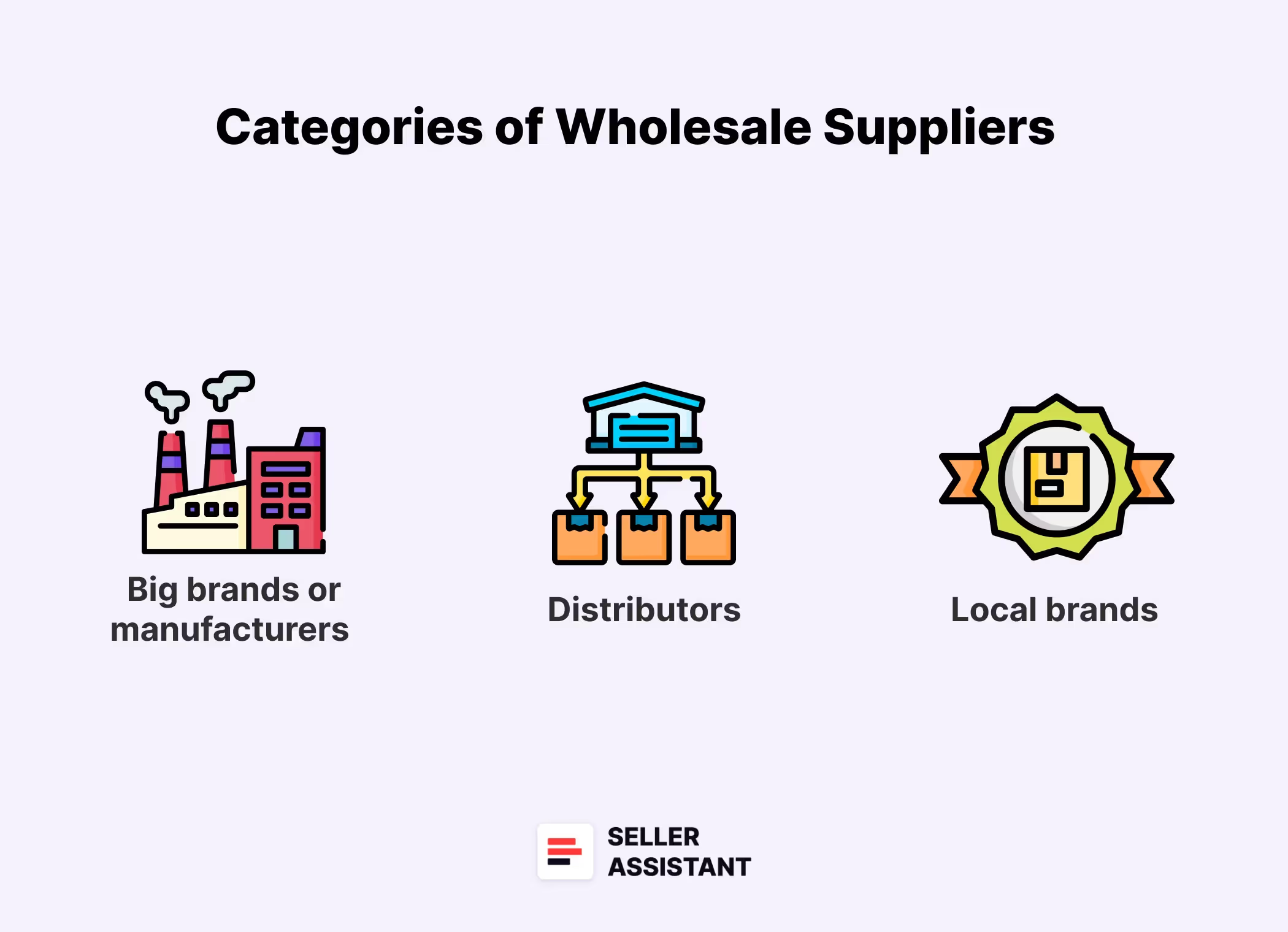
Related: 12 Ways to Find Wholesale Suppliers for Amazon FBA
How to Find Amazon FBA Wholesale Suppliers
How to Buy Wholesale to Sell on Amazon?
When it comes to sourcing for your Amazon FBA business, you have three major types of wholesalers. Let's explore the strengths and limitations of each.
Big brands or manufacturers
Major brands and manufacturers are entities that produce goods on a large scale and typically have well-established reputations and widespread brand recognition.
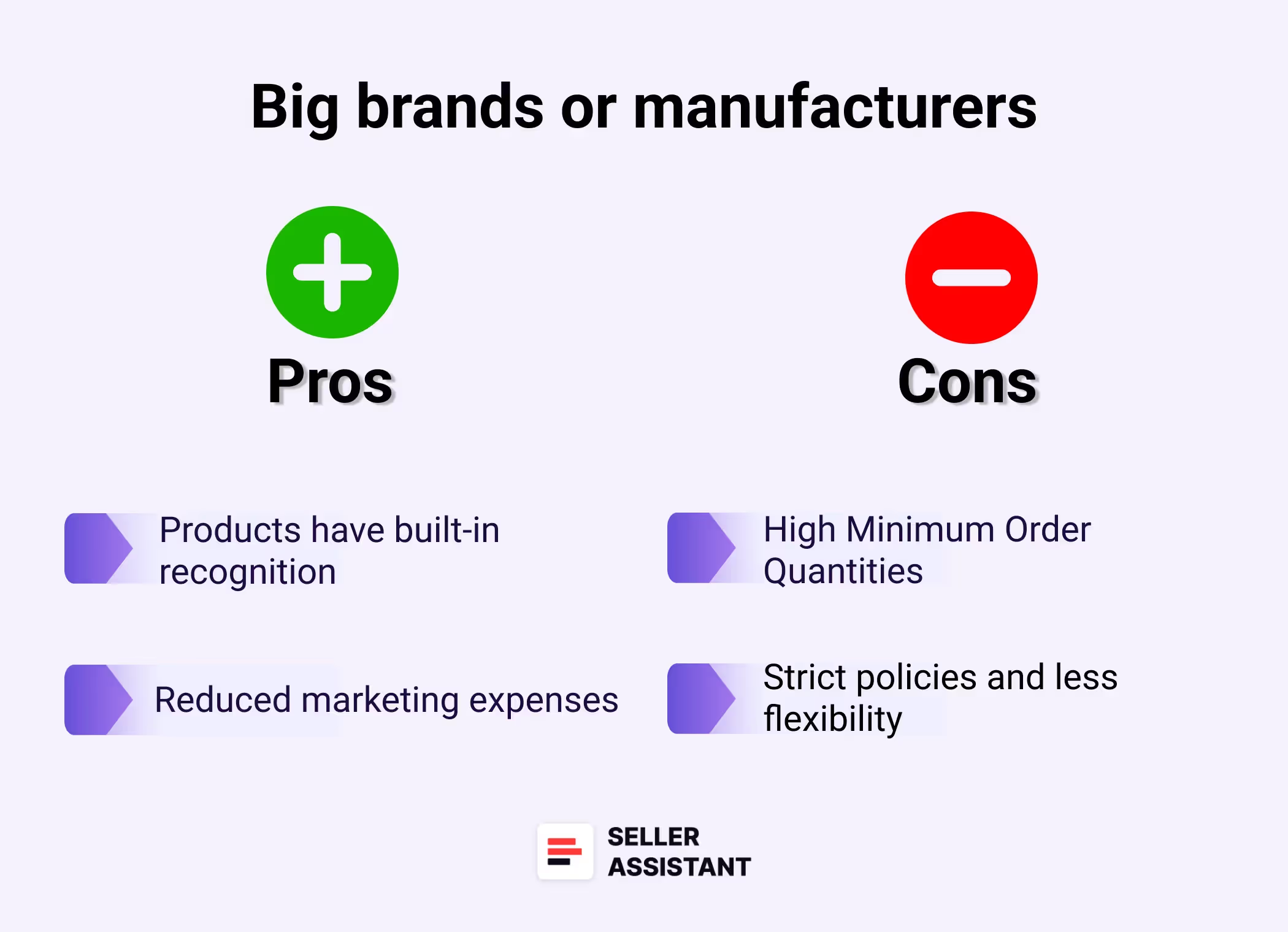
Related: How to Choose Wholesale Products to Sell on Amazon?
Online Arbitrage vs Wholesale on Amazon. What is the difference?
How to Master Wholesale Distribution for Amazon
Suitable for
- Experienced sellers with a solid business foundation who can handle high minimum order quantities (MOQs);
- Sellers with larger budgets capable of investing in bulk purchases and managing higher upfront costs.
Pros
- Products from major brands come with built-in customer trust and recognition, reducing the need for extensive advertising;
- Popular brands promote their products themselves, saving you advertising expenses.
Cons
- High MOQs can be prohibitive for smaller or newer sellers;
- They tend to have strict policies and offer less flexibility in negotiations and custom orders.
Distributors
Distributors act as middlemen, buying products in bulk from various manufacturers and brands to resell them to retailers. They offer a variety of products from multiple sources.
.avif)
Related: Amazon FBA for Beginners
Suitable for
- Small to medium-sized sellers operating on a smaller scale, as distributors often have lower minimum order requirements;
- Sellers looking to offer a diverse product range without needing to source from multiple manufacturers.
Pros
- Access to a wide range of products from multiple brands and manufacturers;
- Typically lower MOQs compared to purchasing directly from manufacturers.
Cons
- Prices are generally higher than buying directly from manufacturers due to the distributor’s markup;
- Distributors may have their own requirements and policies which can add complexity.
Local brands
Local brands are smaller, regionally-based companies that produce goods on a smaller scale compared to major manufacturers. These brands often focus on quality and uniqueness.
.avif)
Related: Selling on Amazon: How to Make Money?
How to Sell on Amazon for Beginners - Complete Guide
Suitable for
- New sellers looking to stand out with unique products;
- Sellers targeting niche markets or specialized local niches where consumers value the product's story and origin.
Pros
- Offers unique products that help differentiate your business from competitors;
- More flexibility and a greater willingness to negotiate and adapt to your needs.
Cons
- Limited production runs can result in stock shortages;
- More effort is required to build brand recognition and customer trust.
Related: Seller Assistant Extension Review
The Best Amazon Online Arbitrage Tool — Seller Assistant
What Are the Challenges of Finding Amazon FBA Wholesale Supplier?
While sourcing directly from brands or manufacturers offers the best pricing potential, finding a wholesale supplier for an Amazon business has a number of challenges. Below you can find the major challenges and solutions for finding Amazon wholesale suppliers.
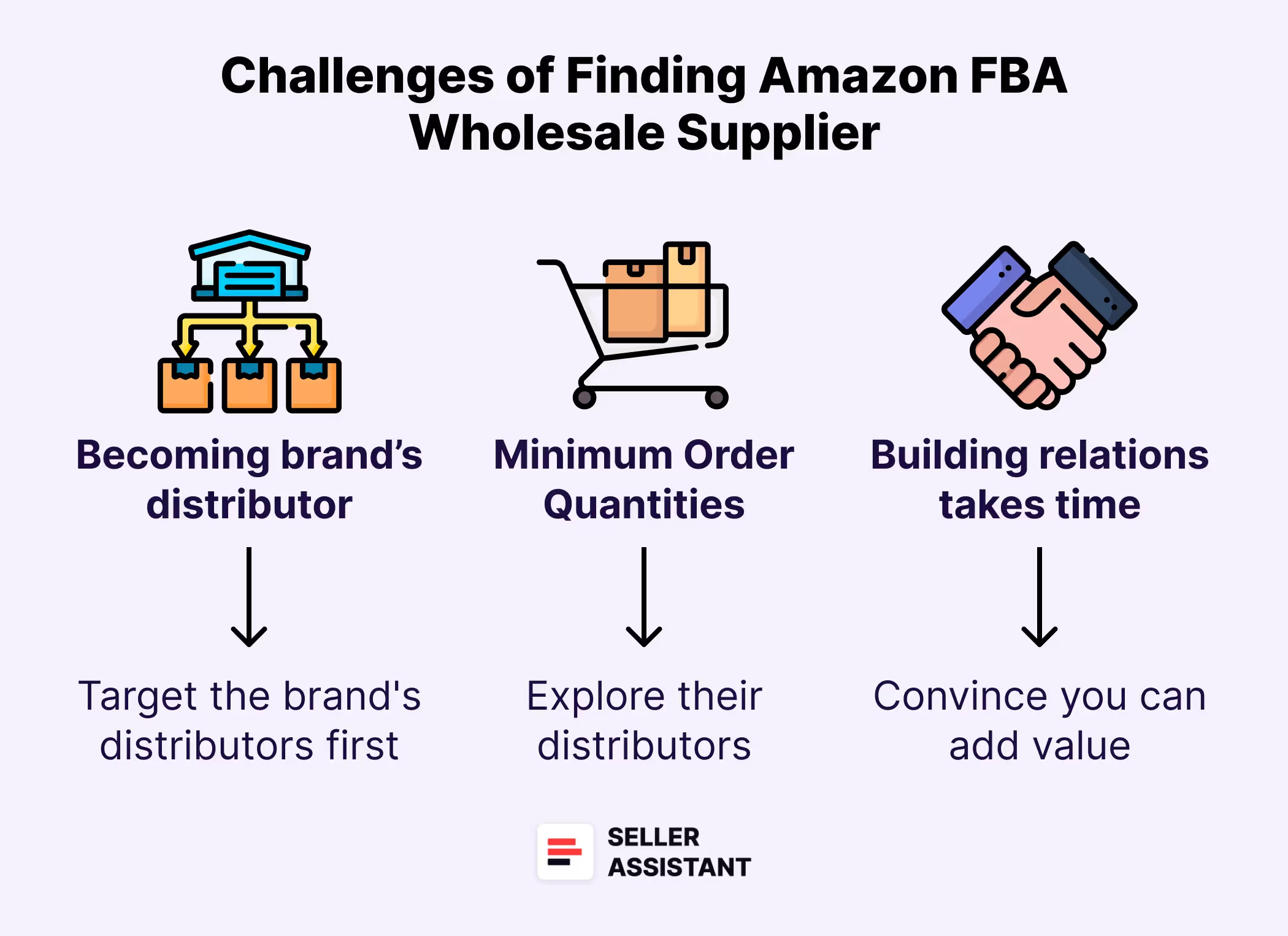
Related: How to Dropship on Amazon with Seller Assistant
Amazon Wholesale: How to Sell Wholesale on Amazon
Becoming brand’s distributor can be tough
Popular brands often have established distribution networks, making it challenging for new sellers to break in. You'll need to convince them of the value you bring as an additional sales channel.
Tip. Target the brand's distributors first. Look for contact information on the brand's website or reach out directly for a list of distributors.
Suppliers prefer multichannel sellers
Some suppliers may favor sellers with a broader reach, including their own online stores, other e-commerce platforms, or physical stores. They might see Amazon sellers as just adding competition and paperwork, not increasing overall sales volume.
Tip. When contacting suppliers, emphasize your role as an online retailer, not solely an Amazon seller. Consider creating a website to showcase your broader reach.
High Minimum Order Quantities
Large brands and distributors often have high Minimum Order Quantities (MOQs). This can require a significant upfront investment, potentially in the tens or hundreds of thousands of dollars.
Tip. If brand MOQs are out of reach, explore options with their distributors who might have lower entry barriers. Local brands often have lower MOQs as well.
Building relations with a supplier takes time
Developing strong supplier relationships takes effort. Use your negotiation skills to demonstrate your potential to boost their sales. Highlight your sales experience as an online retailer and ability to purchase large volumes. As your partnership strengthens, negotiate for better deals.
Tip. Rejection is common when reaching out to new suppliers. Be persistent and focus on convincing them you can add value to their business and increase their sales.
Related: Do You Need an LLC to Sell on Amazon?
How to Contact Amazon Seller Central Support
12 Methods to Finding Wholesale Suppliers for Amazon
When you decide what type of wholesale supplier you are looking for, you must start hunting particular suppliers. Below you can find 12 practical methods that will help you spot new wholesale suppliers for those sellers who already have them, and find the first suppliers for those who don’t have them yet.
Method 1. Choose from 500+ US suppliers with Seller Assistant
If you are looking to expand your supplier base or don’t have a supplier yet, use the List of 500+ US suppliers we propose to find suitable suppliers. Each of them is a proven and reliable company.
When you made your choice, contact the supplier, and get the price list from those suppliers who wish to cooperate with you.
Then, upload the price list to Price List Analyzer by Seller Assistant. This tool automatically researches bulk supplier price lists and identifies the profitable deals you can on Amazon. Download the report and filter out the deals by desired profit and ROI levels.
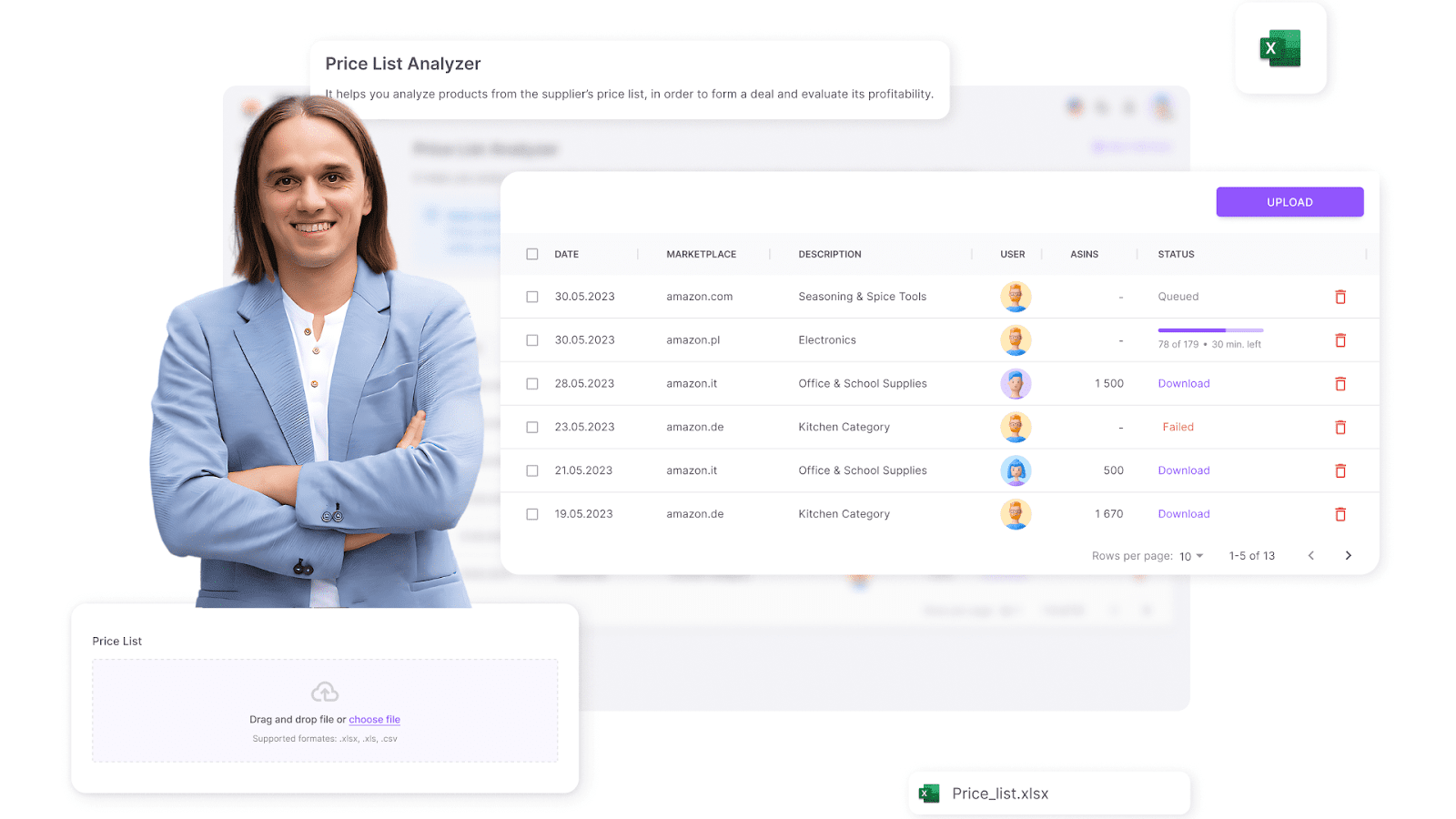
Price List Analyzer is an Amazon wholesale price list scanning tool designed to streamline the research process for identifying profitable products from bulk price lists, making it easier to find the best deals to sell on Amazon.
This tool is ideal for Amazon wholesale, online arbitrage sellers, and dropshippers. It automates bulk product research and provides a simplified way to identify high-margin leads effortlessly.
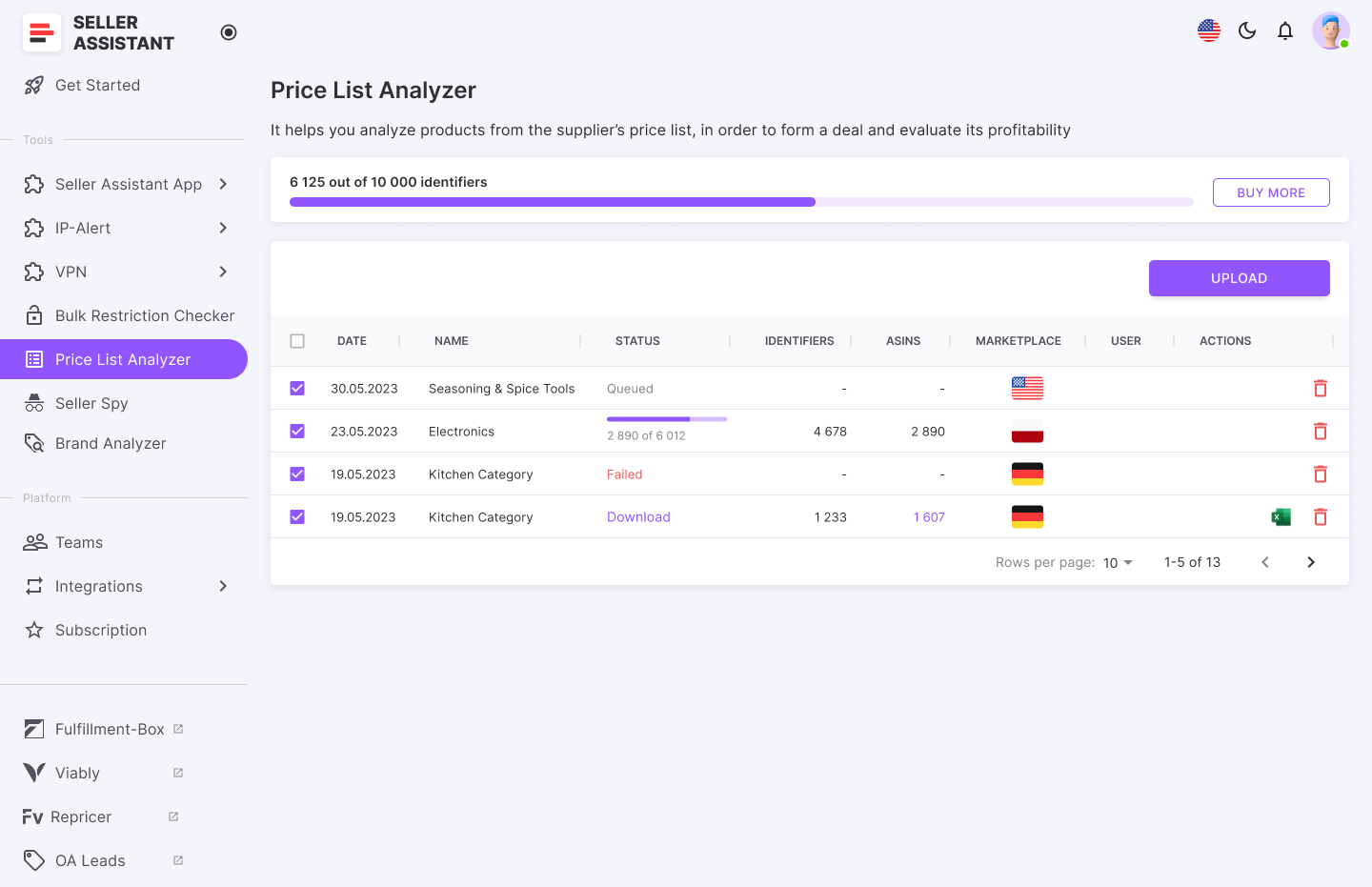
Wholesale sellers can utilize this tool to analyze supplier-provided price lists, pinpointing low-risk, profitable products with strong sales potential. Similarly, online arbitrage sellers and dropshippers can scan supplier websites, automating their analysis to discover lucrative leads.
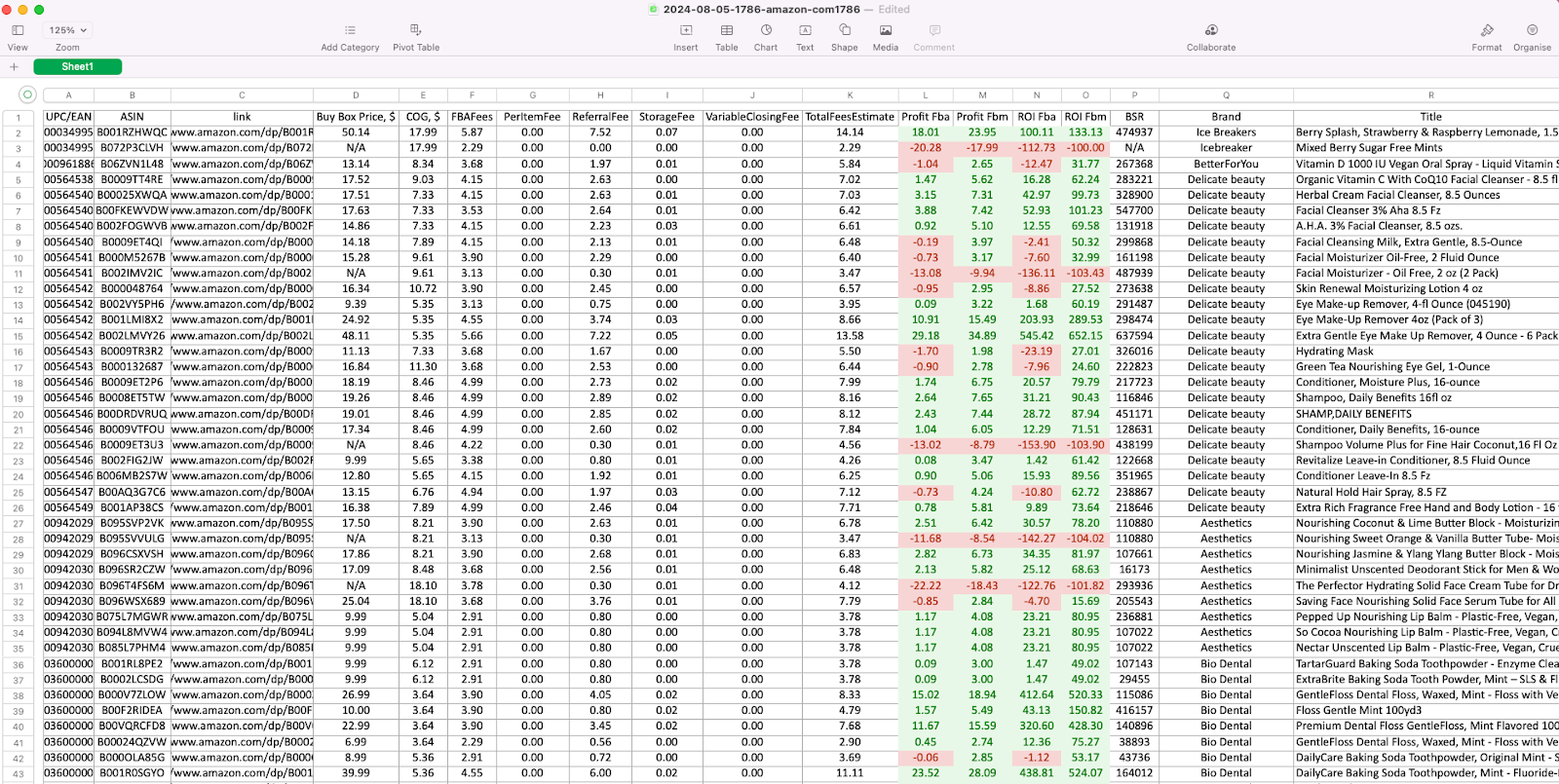
Features of Price List Analyzer
- Automated matching
The tool matches supplier products with their Amazon counterparts, calculates profitability, and displays critical metrics.
- Customizable filters
Results can be filtered by any chosen metric to easily identify profitable opportunities and potential risks.
- Profitability insights
It simplifies the detection of high-margin products by providing data on profitability and ROI, saving hours of manual effort.
- Comprehensive data enrichment
Enriches wholesale sourcing tables with all necessary metrics, enabling users to select the most promising Amazon deals.
- Efficient bulk processing
Processes large supplier price lists quickly and includes advanced filters for smarter product sourcing.
- Performance and risk alerts
Provides detailed insights, including expected profit, ROI, sales velocity, and potential sales volume, while automatically flagging issues such as oversized items, HazMat status, meltable goods, IP complaints, and product variations or bundles.
- Built-in alerts and warnings
Price List Analyzer flags potential risks, ensuring sellers can avoid problematic items. These alerts include:
- Oversized, fragile, meltable products, or those requiring special handling like HazMat.
- Products with IP complaints, missing FBA fees, or no COGs data.
- Issues like "No Buy Box Price," "Approval Required," or unsuitable ROI values ("Too Low" or "Too High").
Related: What Products to Avoid Selling on Amazon?
How to Check Amazon IP Complaints
The Most Important Amazon Seller Metrics for FBA Businesses
Best for
Experienced wholesale sellers in search of new suppliers and new sellers who don’t have any wholesale suppliers but what to grow their business to wholesale.
Tips
- When contacting a supplier, focus your application around your online retail activities, and specify selling on Amazon, among others. Saying that you are selling on Amazon only reduces your chances to win a supplier.
- Make sure a supplier is a wholesaler or distributor, and not a retailer. Carefully review their website and find this information. They can also have a dedicated application form for wholesale resellers. Also, if they represent many brands, that may indicate a supplier is a wholesaler or distributor.
Note. Seller Assistant is a comprehensive product-sourcing software that helps Amazon sellers quickly find high-profit deals. It combines two extensions: Seller Assistant Browser Extension, and IP-Alert Chrome Extension by Seller Assistant, Amazon seller tools: Bulk Restrictions Checker and UPC/EAN to ASIN converter, and features: Side Panel View, FBM&FBA Profit Calculator, Quick View, Seller Spy, Stock Checker, IP Alert, and Restrictions Checker.
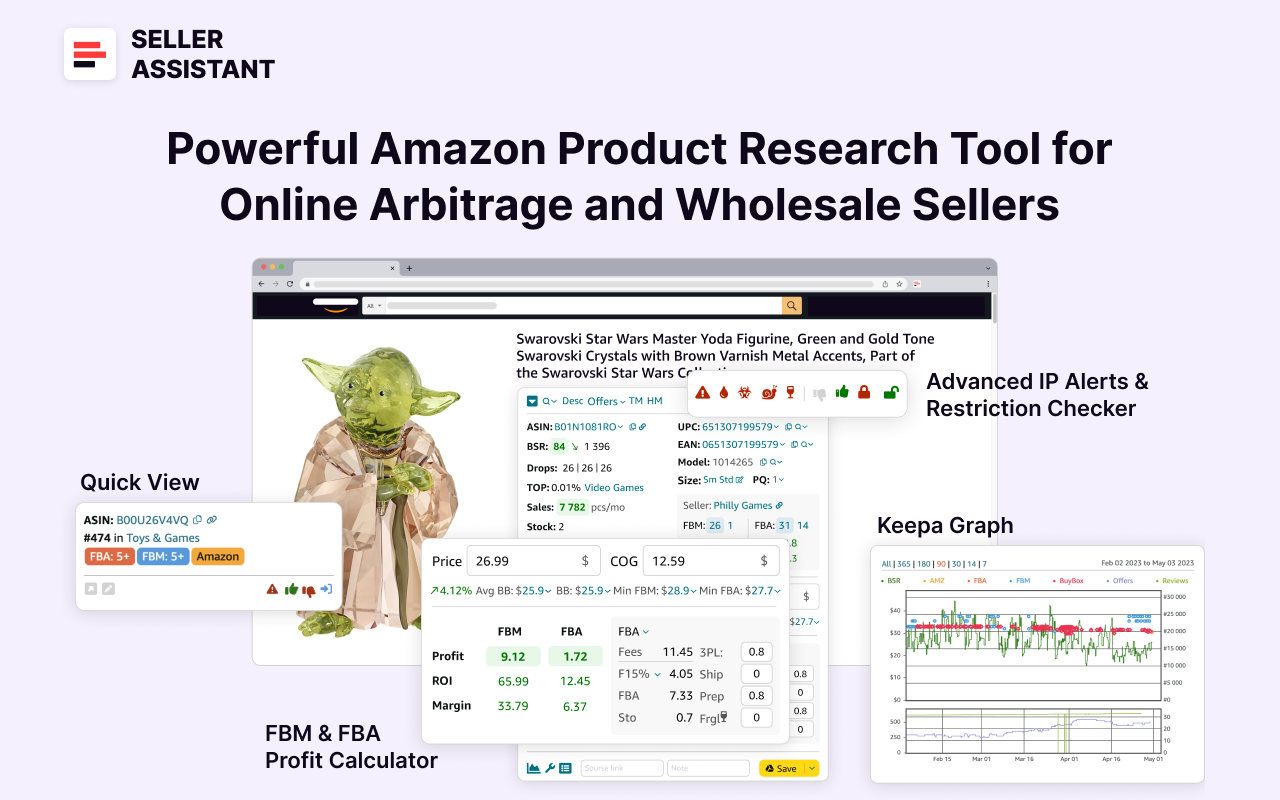
Related: Amazon Account Health – A Guide for FBA Sellers
Amazon Account Health Assurance
What is Amazon Seller Account Health Rating?
How To Avoid Amazon Seller Account Suspension?
Seller Assistant shows all essential product data on Amazon search, product, and inventory pages, and on any website to help you find high-margin deals. By using this FBA and FBM product sourcing software, you can easily identify products that have the potential to be sold well on Amazon.
Method 2. Reach out to the brand directly
Approach the brand directly to express your interest in purchasing their products. Discuss pricing requirements and ask about the minimum order quantities necessary to achieve your desired price points.
Best for
Sellers with multiple distribution channels and substantial capital, as this often necessitates a significant initial investment, possibly in the tens of thousands of dollars. Successful implementation can lead to exclusive or semi-exclusive distributor status.
Tips
- Make sure you are eligible to sell a brand on Amazon. Use Seller Assistant’s Bulk Restrictions Checker. It shows if a brand or product is restricted or you can't sell it on your Amazon account. If you see a green open lock icon, you can sell them. If you see a red closed lock, you can’t sell brands or products without Amazon’s approval and they are restricted. If the tool shows a red closed lock with an exclamation mark, you are not eligible to sell the brands or products on your account.

Related: Amazon’s Vine Program for Sellers: What Is It? And Is It Worth It?
Building Reputation for Amazon Store — Everything Sellers Need to Know
- Prepare a business case. Highlight your distribution capabilities and discuss the pricing you expect to get in exchange to order quantities required by the brand. Focus on building a strong, long-term relationship with the brand to secure favorable terms in the future.
Method 3. Contact authorized distributors
If you are not sure you can meet the brand's Minimum Order Quantities or they don’t want to add you to their distributor network, you can still buy the brand’s products through their distributors.
Visit the brand's website to find a list of their authorized distributors. Contact these distributors to discuss becoming a reseller and understand their minimum requirements.
Best for
Sellers looking to access authentic products without the direct burden of high MOQs from the brand itself.
Tips
- Verify distributor credentials. Ensure the distributor is authorized and reputable by checking with the brand’s website.
- Offer becoming a distributor’s reseller and make sure you can meet the minimum requirements they may have.
Related: What Is an ASIN?
How to Create an Amazon Seller Central Account
Method 4. Find a brand on Amazon
If you are looking to resell a brand, you can start your search from Amazon, and then approach that brand or find its supplier. This sourcing method is called reverse sourcing. In that case, you must look for a brand that sells well, but it shouldn't be extremely popular to avoid fierce competition.
Choose brands that have at least 500 products listed on Amazon, because some products may not meet your resale criteria. Also, make sure that the brand itself does not sell on Amazon. Ensure you can sell a brand on your Amazon account and it doesn’t have Amazon policy violations. On top of that you must check if a brand meets your revenue targets, competition from Amazon and other sellers, and overall brand’s popularity and reputation.
You can automate checking all this data with Seller Assistant’s Brand Analyzer. Brand Analyzer is a powerful Amazon brand research tool designed to help sellers identify profitable brands for resale. Conducting thorough brand research is a crucial first step in product sourcing, and Brand Analyzer automates this process to ensure the chosen brand aligns with your revenue goals and selling criteria.

By simply entering a brand name, you can access comprehensive data to determine whether the brand is suitable for reselling on Amazon.

Additionally, you can generate detailed reports that include all the brand's products along with their specific metrics.
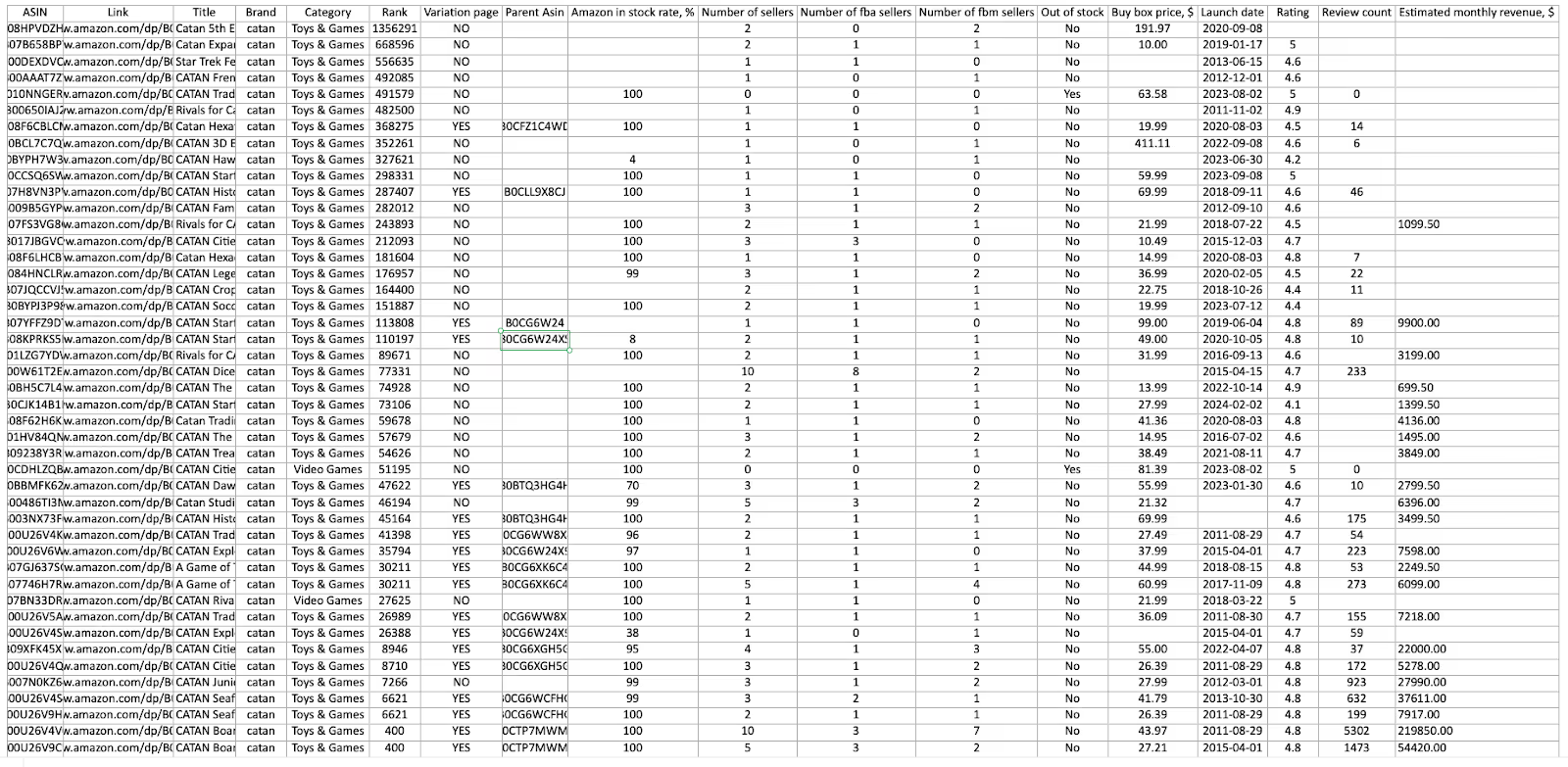
Features of Brand Analyzer
- Resale potential assessment
Evaluates whether a brand is resale-friendly and worth pursuing as a supplier.
- Time-saving automation
Streamlines the research process, making it faster and more efficient to find profitable brands.
- Revenue estimation
Calculates potential monthly revenue by analyzing the total revenue generated by the brand's products.
- Buy Box insights
Provides data on Amazon's Buy Box share for the brand's products, offering a clear view of competition levels.
- Competition metrics
Shows the average number of FBA sellers per product, helping you gauge competition and profit potential.
- Product portfolio evaluation
Lists the total number of products offered by the brand, giving insight into its market presence.
- Customer satisfaction metrics
Analyzes the brand’s reputation and customer satisfaction through total reviews and average ratings.
- Pricing insights
Displays the average Buy Box price for the brand's products, aiding in competitive pricing strategies.
- Cost breakdown
Provides average FBA fees for the brand’s products to help sellers calculate accurate costs.
- Key metrics overview
Summarizes critical data points such as revenue, stock availability, competition, pricing, and customer feedback.
- Profit potential identification
Pinpoints brands that are resale-friendly and likely to yield high-profit margins.
Best for
Experienced wholesale sellers in search of new suppliers and new sellers who don’t have any wholesale suppliers but what to grow their business to wholesale.
Tips
- You can choose the brands selling products that generate recurring sales.
Examples. Pet supplies (pet food, cat litter, pet grooming products), office supplies (printer paper, ink cartridges, pens, notebooks), cleaning supplies (dish soap, disinfectant wipes, trash bags).
- Make sure the brand is not sold by Amazon. Competing directly with Amazon is challenging, and if Amazon sells more than 30% of a brand’s products, it’s better to find another brand to avoid extreme competition. You can identify such products with Seller Assistant's Brand Analyzer. It shows the data in the Amz In-stock Rate column.
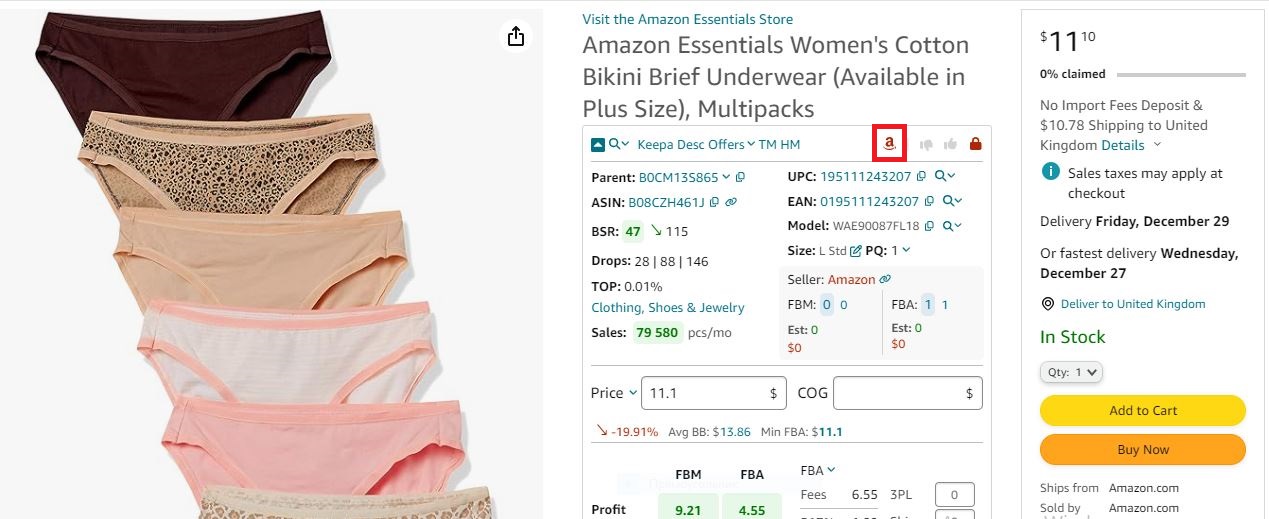
Method 5. Utilize existing suppliers to discover new ones
Suppliers often represent multiple brands. Once you have a good relationship with a supplier, ask about other brands they distribute or check their website for a list of brands. This can open up new opportunities and help diversify your product range.
Best for
Sellers looking to expand their inventory and explore new brands through existing supplier relationships.
Tips
- If you sell several brands from your supplier, explore all the brands listed on their website. Request the whole supplier price list and look for other brands that may sell well on Amazon.
- Use Price List Analyzer by Seller Assistant to automate scanning wholesale price lists and identifying profitable deals in bulk..
Method 6. Leverage supplier relationships for quality connections
A strong relationship with a supplier can help you find other high-quality suppliers they may mention or recommend if they don’t sell specific brands. Trusted suppliers are more likely to recommend reputable counterparts, helping you maintain a high standard of inventory.
Best for
Sellers aiming to maintain high inventory standards and expand their network of reliable suppliers.
Tips
- Keep open and positive communication lines with your suppliers. Ask your suppliers for recommendations to other reliable suppliers.
- Ask your prep center or 3PL. They can recommend reliable suppliers who use their services and have substantial inventory turnover. Also, prep centers know what brands the suppliers sell because they prep the inventory.
Method 7. Concentrate on a niche market
Choose a specific, narrow product niche that you are familiar with and that shows market potential. Use search engines to find distributors within this niche. Specializing in a niche allows you to become an expert and cater to specific customer needs.
Best for
Sellers who want to specialize and target specific customer groups with unique products.
Tips
- Do product research. Identify niche products with good demand and low competition. Develop in-depth knowledge about the niche. Use the expertise about such products you may already have.
Examples. Luxury camping gear targeting the growing market of consumers who seek luxury and comfort in outdoor activities (high-end camping hammocks, premium portable grills, eco-friendly camping cookware);.specialized fitness equipment for fitness enthusiasts who need specialized or portable equipment for specific workouts (adjustable resistance bands for travel, compact home workout gear, niche sport-specific training equipment).
- Focus on finding brands and distributors that specialize in your chosen niche.
Method 8. Partner with local brands
Reach out to small, local brands or distributors, especially if you already resell products from brands in the same area. Starting with smaller, family-owned brands can provide more openness to partnerships with new sellers.
Best for
New sellers looking for unique products and willing to start with smaller, local brands.
Tips
- Attend local trade shows. Use local trade shows to find and connect with small brands.
- Promote local products. Highlight the uniqueness and local origin of the products to attract customers.
Method 9. Follow the supplier’s distribution network
Leverage your existing connections to find suppliers within your current distribution network. Suppliers you know from previous dealings or personal connections can lead to reliable supply channels.
Best for
Sellers looking to use their existing network to find reliable suppliers.
Tips
- Map your network. Identify suppliers within your existing network and their distribution routes. Ask your relatives and friends for their connections.
- Leverage relationships. Use your relationships to negotiate better deals and secure consistent supply.
Method 10. Analyze competitors
Study the brands and products that your successful competitors are selling. With Seller Assistant’s Seller Spy, you can quickly identify new brands and products your competitors have started or stopped selling, as well as how they price each item. Use these insights to replicate their success.
Seller Spy automatically monitors your Amazon competitors you want to track, and informs you what new brands and products your competition started or stopped selling, and how they price each product.
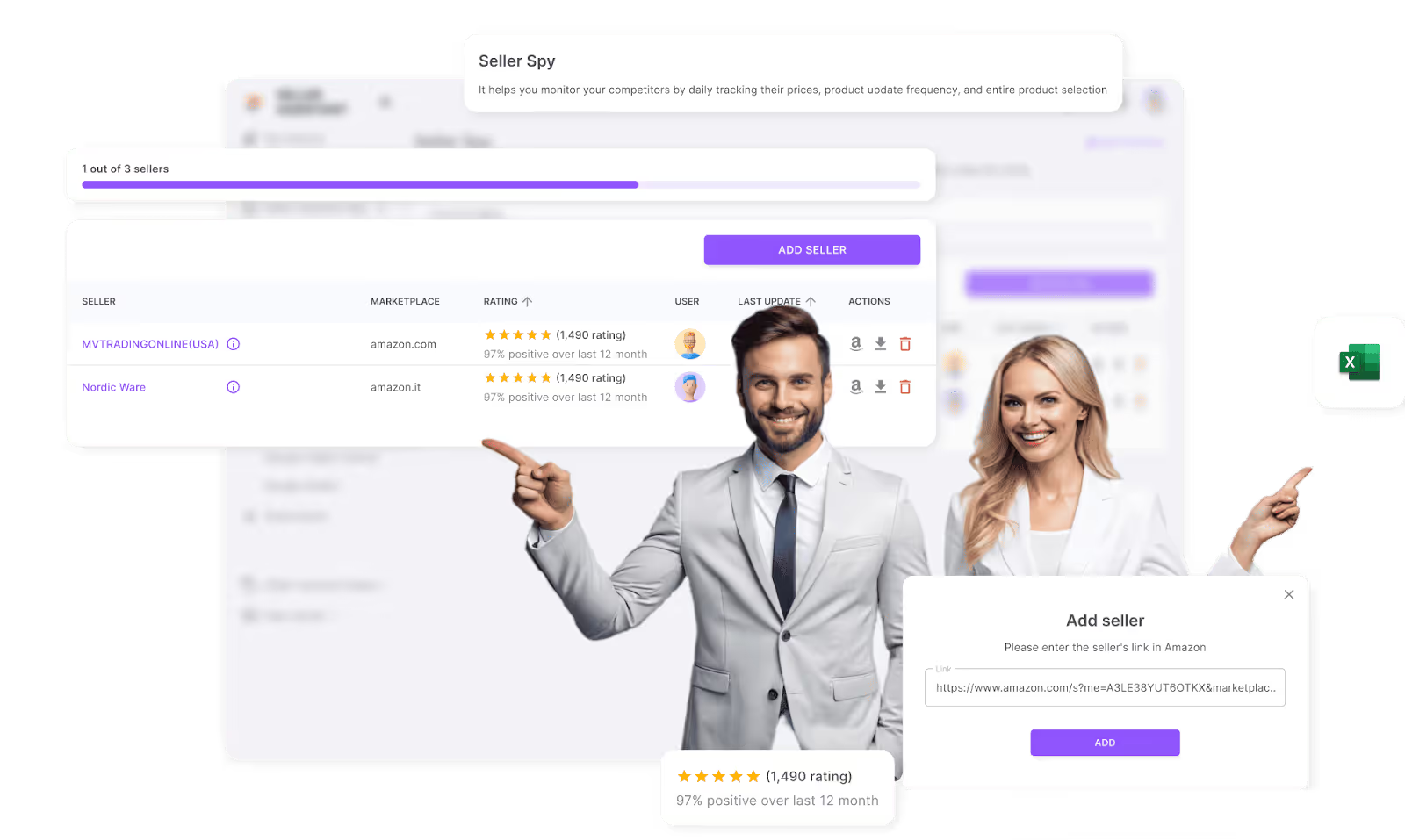
Seller Spy automatically monitors your Amazon competitors you want to track, and informs you what new brands and products your competition started or stopped selling, and how they price each product.

Using this valuable data, you can expand your store by adding similar or identical products and fine-tune your pricing to stay competitive.
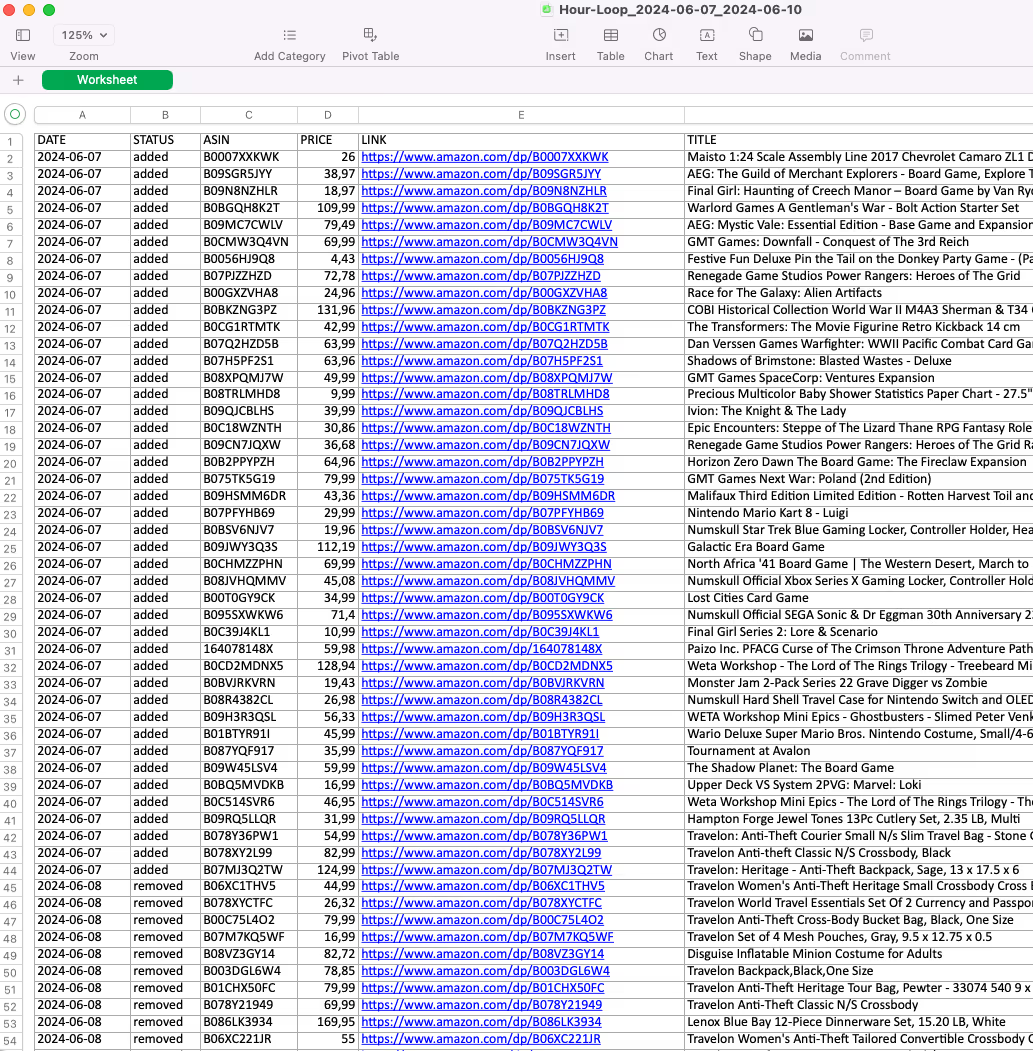
Features of Seller Spy
- Automated competitor analysis
Simplifies the process of monitoring competitors’ activities.
- Product tracking
Identifies products your competitors have added or removed from their inventory.
- Market expansion
Highlights products your competitors sell that you do not, providing opportunities to broaden your catalog.
- Pricing insights
Monitors competitor pricing to help you adjust your prices, ensuring competitive positioning and optimized profit margins.
Best for
Sellers who want to emulate successful competitor strategies to find profitable products.
Tips
- Actively identify gaps. Look for gaps in your competitors’ product offerings that you can fill.
- Adjust your sourcing and pricing strategies based on competitor insights. But don’t forget about your break-even point (0% profit margin).
Method 11. Consult wholesale directories
To find Amazon FBA suppliers, use wholesale directories, which list various brands and suppliers worldwide.
Examples
- Wholesale Central: free directory that lists a variety of wholesale suppliers across multiple categories, making it a valuable resource for retailers;
- SaleHoo: A paid membership directory providing access to verified suppliers, along with market research tools and resources;
- ThomasNet: leading directory for industrial suppliers in North America, offering a wide range of products and services;
- Worldwide Brands:directory of certified wholesalers and drop shippers, ideal for eCommerce businesses;
- TopTenWholesale: directory connecting wholesale buyers with suppliers, featuring various product categories and industries;
- Wholesale Deals: UK-based directory that offers information on the best wholesale deals and suppliers in various product categories;
- Kompass: global B2B directory that helps you find manufacturers, suppliers, and wholesalers for various industries;
- Alibaba: one of the largest global wholesale marketplaces, offering a vast selection of products from suppliers worldwide;
- Global Sources: B2B platform for finding wholesale suppliers, particularly from Asia;
- DHgate: wholesale marketplace similar to Alibaba, primarily focused on products from China.
Best for
Sellers seeking a diverse range of suppliers and products across different categories.
Tips
- Select reputable directories. Narrow down your search to specific categories that align with your business needs.
- Verify supplier legitimacy. Check reviews and ratings of suppliers listed in directories to ensure their reliability.
Method 12. LinkedIn it
LinkedIn is a perfect tool for connecting with potential wholesale suppliers in your industry. By using LinkedIn's search filters, you can find companies that align with your sourcing needs.
Filter by company type, industry, set the location filter to the United States or any other region where you are looking to source products, and company size to pinpoint wholesalers who can supply the products you need.
Best for
Sellers who prefer direct engagement with suppliers and want to leverage professional networks to find reliable wholesale sources.
Tips
- Send personalized messages. When you find a potential supplier, send a personalized message introducing your business and expressing your interest in their products.
- Join industry groups. Participate in LinkedIn groups related to your industry to connect with potential suppliers and gain insights into market trends.
FAQ
Where to buy items to resell on Amazon?
You can purchase items to resell on Amazon from a variety of sources, including brands or wholesale suppliers, online retailers, liquidation sales, and trade shows. Each source offers different types of products and varying levels of pricing and quantity requirements.
How do I find someone's Amazon supplier?
To find brand's official distributors, go to the brand’s website. They typically publish a list of distributors in a specific section.
How to buy bulk of items and sell them on Amazon?
To buy items in bulk for reselling on Amazon, you can source products from wholesale suppliers, manufacturers, or bulk buying platforms. You must contact the supplier of your choice, get the price list, and choose profitable deals with Seller Assistant’s Price List Analyzer.
How do you find wholesalers?
You can find wholesalers by attending industry trade shows, joining wholesale directories like SaleHoo or Worldwide Brands, and networking on professional platforms like LinkedIn. Additionally, contacting manufacturers directly can lead to connections with authorized wholesalers.
Which is the best place to buy wholesale items?
The best place to buy wholesale items depends on your specific needs, but popular options include wholesale directories like Alibaba for international products, SaleHoo for verified suppliers, and local trade shows for niche or regional products. Each offers access to a broad range of suppliers and products.
How do you supply wholesale?
To supply wholesale, you need to establish relationships with manufacturers or authorized distributors and purchase goods in large quantities to get bulk discounts. Then, you can sell these products to retailers or through platforms like Amazon or eBay, ensuring you comply with legal and logistical requirements for wholesale trade.
Final Thoughts
As an Amazon wholesale seller, your key task is to find a supplier and agree about the cooperation on win-win terms. To do that, when you get a price list from the supplier, you must quickly analyze the offered products and find profitable deals you can sell on your Amazon account.
Seller Assistant's Price List Analyzer can automate this process, allowing you to quickly identify the most high-margin products in your supplier list.
Seller Assistant is an all-in-one product sourcing software offering all the features vital for product sourcing. It combines three extensions: Seller Assistant Extension, IP Alert, and VPN by Seller Assistant, tools: Price List Analyzer, Brand Analyzer, Seller Spy, Bulk Restrictions Checker, and API integrations, and features: Side Panel View, FBM&FBA Profit Calculator, Quick View, ASIN Grabber, UPC/EAN to ASIN converter, Stock Checker, and other features that help quickly find high-profit deals. Seller Assistant also offers integration with Zapier allowing to create custom product sourcing workflows.
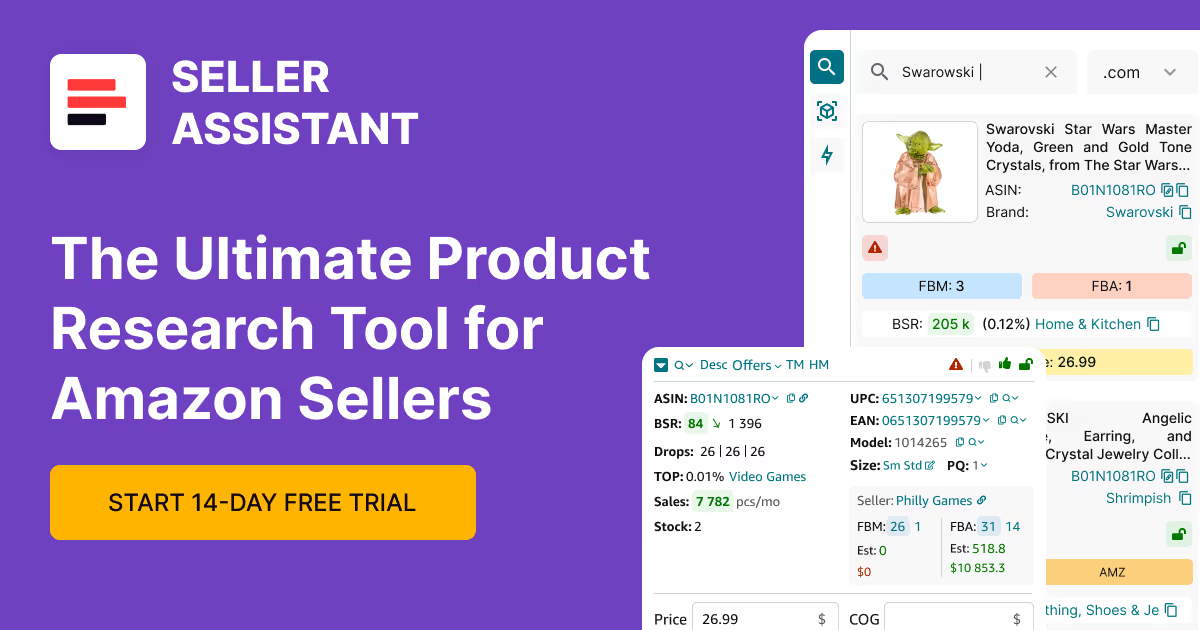
.svg)













